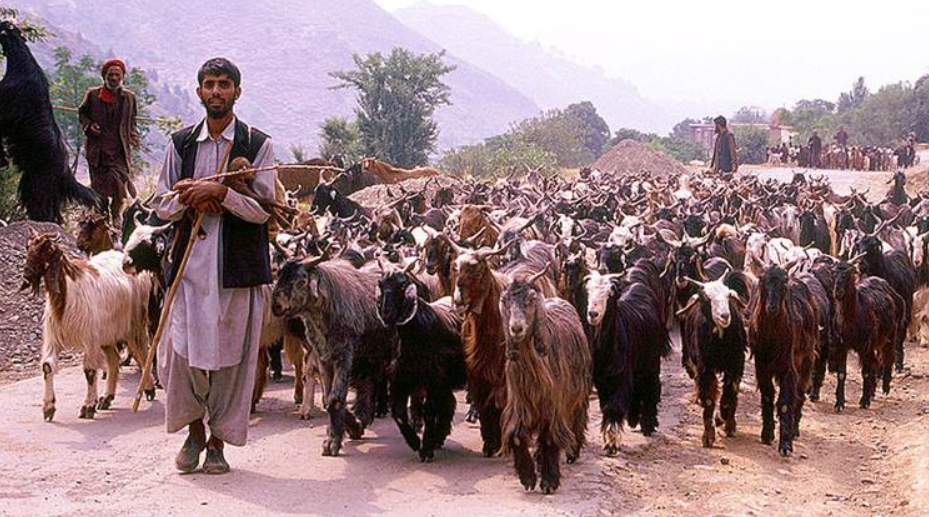Gujjars, Bakerwals to hit the streets over ST tag for Paharis
Context
Gujjar and Bakerwal protest marches against the inclusion of upper caste Paharis on the Schedule Tribe (ST) list are becoming more and more popular in J&K. If the Center does not remove the Bills submitted in Parliament, they have threatened to take to the streets with their livestock.
About Bakarwal
- Ethnic Identity: The nomadic Bakarwal people live in the Indian Union Territories of Jammu & Kashmir and Ladakh. Their name can also be written Bakkarwal, Bakharwal, Bakrawala, or Bakerwal. Their distinctive cultural identity and traditional way of life are well-known.
- Scheduled Tribes: Since 1991, the Bakarwal and Gujjars have been recognized by the government as Scheduled Tribes. They now have specific constitutional rights and safeguards in India as a result of this recognition.
- Geographical Range: The Pir Panjal region in the Indian Himalayan ranges and the Zanskar region are the starting points for Bakarwal’s nomadic existence. They are also believed to live in the Afghan region of Nuristan and the Hindukush highlands.
- Livelihood: Goat- and sheep-herding is the Bakarwal community’s main source of income. For food and economic activities, they rely significantly on their livestock, especially goats, sheep, and other cattle.
- Seasonal Migration: The Bakarwal migrate from one location to another during the year to maintain their herds. These migrations are frequently prompted by the need to find better grazing areas and conducive weather for their cattle.
- Gujjar Bakerwal: The Gujjar Bakerwal community is the third-biggest ethnic group in the Indian portion of Jammu and Kashmir and the largest Muslim tribe in the country of India. This emphasizes how numerous they are and how important they are culturally to the area.
- Cultural Significance: The Bakarwal have a rich cultural legacy that consists of distinctive traditions, rituals, music, dance, and crafts. Their way of life and mythology are intricately entwined with their nomadic lifestyle and the surroundings they call home.
- Resilience and Adaptability: The Bakarwal have acquired the knowledge and skills necessary to adjust to a variety of climatic and topographic circumstances through many generations. They are resourceful and robust because of their capacity to flourish in demanding environments.
- Social Structure: The Bakarwal community has a traditional social structure with roles for males, women, and elders that are clearly defined. They have their own elected officials and political structures.
About Pahari People:
- Pahari People
- In the Jammu division of Indian-administrated Jammu and Kashmir, the Pir Panjal Region, Kishtwar, Ramban, and Doda districts, as well as territories bordering Himachal Pradesh, are home to several diverse communities known as the Pahari people.
- There are also some Pahari-speaking people in several areas of Azad Kashmir, which is administered by Pakistan.
- Languages Spoken in Pahari:
- A set of Northern Indo-Aryan languages that are predominately spoken in the lower Himalayas are referred to as “Pahari” in this context.
- Eastern Pahari, Central Pahari, and Western Pahari are the three primary groups into which these Pahari languages can be generally divided.
- Diversity of Culture
- Because of their extensive geographical distribution and historical connections with adjacent communities, the Pahari people exhibit a tremendous amount of cultural diversity.
- The diverse cultural fabric of the area is enriched by the distinctive traditions, rituals, and practices of each Pahari-speaking group.
- Linguistic differences
- There are nuances and dialects unique to various communities and sub-regions within the Pahari-speaking languages.
- The Pahari language family is complex due to its linguistic diversity, making it a topic of study for linguists and scholars.
- Political and Social Context
- Throughout history, the Pahari people have been a part of numerous kingdoms and empires that dominated the Himalayan region.
- Language, culture, and identity development among the Pahari-speaking communities have been shaped by sociopolitical history.
What are the bills passed to induct Pahari groups under the ST category?
- The three Bills introduced in Parliament are
- The Constitution (J&K) Scheduled Castes Order (Amendment) Bill, 2023
- The Constitution (J&K) Scheduled Tribes Order (Amendment) Bill, 2023
- The J&K Reservation (Amendment) Bill, 2023
- If passed, these Bills will include Paharis, Gadda Brahmins, and Koli in the ST list in J&K.
- The protesters are also against the intention to include Valmikis in the Scheduled Caste (SC) list.
What is the issue between these two groups?
- Background: In Jammu and Kashmir, the Gujjars and other tribal groups were already recognized as Scheduled Tribes in 1991. Reservations in employment, education, and other government programs are among the privileges that Scheduled Tribes enjoy to improve their socioeconomic position.
- Demand for ST Status: The Pahari Speaking People (PSP) of Jammu and Kashmir are asking to be recognized as a Scheduled Tribe. They speak dialects of Pahari classified as Lehnda Group and claim to be of the Pahari ethnic group.
- Gujjar Opposition: The Gujjars and other existing tribal communities are opposed to the Pahari Speaking People being granted ST status. They contend that it would negatively impact the benefits and development offered to the current tribes and weaken the entire Scheduled Tribe designation.
- Linguistic Identity: Pahari-speaking individuals’ main justification for requesting ST classification is their language identity. They contend that their unique language and cultural characteristics make them eligible for Scheduled Tribe designation.
- Social and Caste Differences: According to Gujjars, the majority of Pahari-speaking individuals are members of upper-caste Muslim and other upper-class communities, including the Syeds, Qazis, Pers, Begs, Rajas, Maliks, Khans, Kashmiris, Mughals, Rajputs, Hindus, upper-caste Sikhs, Hindu castes, Brahmins, and Christians. According to the Gujjars, these communities do not experience the same social discrimination or caste-based prejudice that the current tribes do.
- The Gujjars note that the literacy rate among the current Scheduled Tribes of Jammu and Kashmir is lower (50%) than that of the Pahari Speaking People, notably in Poonch and Rajouri districts, where it is supposedly 68%, according to the 2011 census. They fear that granting ST status to Paharis might further widen this educational gap and adversely impact the existing tribes’ development.
- Existing Reservations: According to the Gujjars, the Pahari Speaking People already receive benefits from several reservation categories, including a 4% reservation under the Actual Control Line habitat, a 10% reservation under the RBA (Reserved Backward Area), a 4% reservation under other social castes, a 10% reservation under the economically weaker section, and a 4% reservation under Pahari Speaking. If they were given ST status, they would have access to the 10% reservation currently reserved for Gujjars.
- Complex Issue: There are social, economic, and political ramifications to the demand for ST designation and the advantages that go along with it. Finding a solution would necessitate serious thought, discussion, and comprehension of the issues and viewpoints of all parties concerned.





